Digital mastering and the music business
What is 'CD Quality'? Are decent CD players worth buying any more?
Visit The CD Hall of Fame and SHAME.
Have you recently invested £100s or £1000s in a top-end CD player? If so pause for a moment and look at the latest Naim CD player, you'll notice how much care and engineering goes into these things. The detail of thought and design is simply stunning - surely these must sound absolutely brilliant?
Well, er sometimes not, for any HiFI, garbage in still means garbage out, however cool the box in between is.
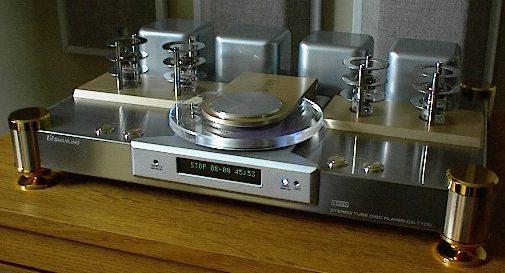
The Shanling CD player
|
The Loudness War/Loudness race
The process of making everything sound as loud as possible, all the time.
In the beginning, CD mastering was in it's infancy and the sound was criticized for being harsh, but as filtering improved, dither was used and mastering methods developed around the medium the sound actually got rather good by the early 90's.
Pink Floyd - "In The Flesh", from The Wall.
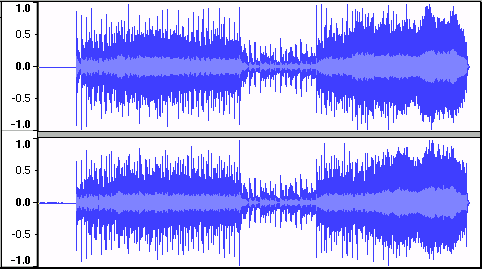
Viewed on Audacity under Linux
A well mastered track with good dynamic range. This is one reason why people appreciate 'Floyd! The music has an extra secret dimension, missing in overcompressed CDs of today.
'Hot' masters
With careful mastering a CD can sound very good. In fact Naim have their own label of correctly mastered CDs, and they do sound very good. The problem appears if you want to listen to stuff that has been produced by the big record companies.
Frankly most popular CDs today are faulty. The modern steps to creating a popular song goes like this:
- A songwriter writes a brilliant song. Lets face it, some modern songs are extremely well written.
-
Highly skilled musicians, and often skilled vocalists came together in a recording studio. The studio uses gold-sputtered electret condenser microphones, top of the line mixers, effects, recording technology.
-
The mix is created by weighting and emphasising the separate musical performances into one artistic whole, checked by some quite reasonable studio monitors.
Occasionally resampling and compression kills the sound here, but in general the music isn't in too much danger. There are loud bits, quiet bits and recognisable voices.
-
Down-conversion, scaling from 24bits (16,777,216 levels) to 16bits (65,536 levels), and usually resampling from 192kHz, 96kHz or 48kHz down to 44.1kHz. We can still hear the music at this stage, it's lost quite a bit but with dither the midrange can still be good.
This is the CD 44.1kHz 16bit standard, it would be nice it the CD was released at this stage.
-
Over-mastering: Now the CD is compared to the other clipped and compressed CDs, to see if it has reached the final magic CD sound. If it still sounds like music, quite unlike the modern CD, the mix is turned up, the dynamics are compressed even more and the signal is brick-wall limited into clipping. Once the super 'sound killer' compressor-limiter is then kicked into action the music dies, the 96dB range of the CD strangled to about 3dB and half of the potential customers will no longer enjoy it.
The Clipping damage can now be counted - and heard, observation shows about 6dB (1 bit) appears to be cut off at the clipping stage, so we are now down to 15bits (32768 levels) with extra odd-order harmonic clipping artifacts (raising THD with loudness).
Certainly the music sounds harsh and unpleasant to many people, depending upon how the users DACs handle clipping and the CD loses a great deal of it's appeal. It's quite possibly why bass-bins are so popular, when the user boosts the bass he is keeping the volume but ditching a lot of the harsh screechy treble and mid too.
Modern music, created by genius, mastered by muppets.
Garbage - "Can't cry these tears", a typical 'hot' master
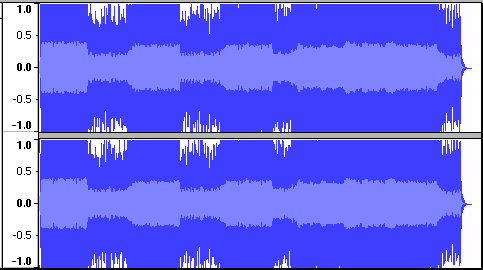
Viewed on Audacity under Linux
This track has 3444 clips on the left channel (max 1ms) and 2709 clips on the right channel (max 0.61ms).
Digital Clipping Distortion
However much compression is squeezed in, and consequent life is squeezed out of the humble CD, the medium should still not 'lose' any information. MP3 is a lossy compression - you can never recover the signal. Ogg is much better but is still throws bits away. The problem with copying CD's as a digital medium (claims the record companies) is that the copy is perfect - nothing is lost. Sadly the original if often far from perfect...
Unfortunately for us, most popular songs have a lot of the information thrown away when it was mastered. Most popular songs are mastered so loud that great big lumps of them are lost forever, in digital clipping distortion. Would you expect the waveform to look like this?
Garbage - "Can't cry these tears", segment of clipping distortion on the original CD

Viewed on Audacity under Linux
The large clip is 44 samples long, or 1ms. I like Shirley Manson and her intrepid band of musicians - I'm just using this track as an example. By modern CD terms it's not actually that bad!. However the mastering is still appalling, a clear case of garbage in, garbage out..
Garbage segment with less gain (as it should have been mastered)
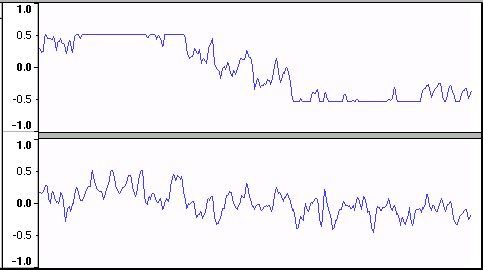
Viewed on Audacity under Linux
Garbage segment with clipping areas reconstructed
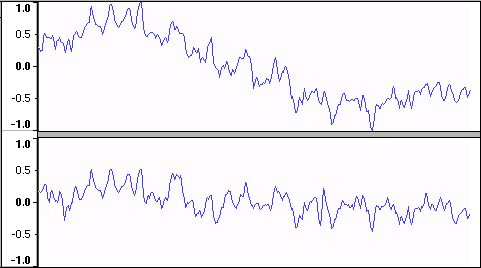
Viewed on Audacity under Linux
It's not hard to appreciate that this track could sound better!
Why digital clipping sounds so bad
Firstly digital clipping is the same as any other clipping, the only difference is that the highest clip frequency is limited to 22.05kHz on a CD, whereas analog can reach 120kHz at times.
- The first audio fact you need to be aware of is that all distortion is not created equal, and within this, odd harmonics sound much worse than even ones. Lynne Olsen discusses the effect here.
-
The Second audio fact is that clipping, or squaring off the waveform creates a great deal of odd harmonics.
Square waves contain all of the odd harmonics from the fundamental (depends on the length of the clip) right up to the highest frequency in the system - on a CD that is 22kHz. For instance a clip of a few points forming a fundamental of 2kHz will create a harmonic at 6kHz, 10kHz and 17kHz.
These harmonics are fleeting and vary on clipping pulse width, but they are there. When listening to a track containing hundreds of clips per second, this forms a random noise field everywhere in the sound spectrum except the lowest notes (unless they beat with other notes to form new tone products, which is quite likely).
As the sound level increases, so does the clipping, and therefore so do the odd order harmonic distortion products, dancing arond the mid and high frequencies as a mass of shifting harmonic distortion that increases steeply with volume.
The increasing noise of the loudness war
The mass of harmonic distortion not only makes MP3s bigger but also makes stuff unpleasant to listen to, because the swirling odd-harmonic noise is objectionable to the human ear. This turns a reasonable Hi-Fi format into a dynamic HF noise generator and the effect can only be one thing - people turn down the volume and switch off.
This effect is parallel to the effect of over-compression, which renders all songs into uniform level blocks of sound, however this distortion is not merely boring and tedious to listen to, it actively works to be switched off (Times Online article). It is this proven scientific hearing phenomena that in the authors opinion is the real cause behind declining CD sales.
Listening without clipping...
Most clips in modern CD tracks are very short, and you'd not notice one or two. Thousands however have an effect, and can sound awful. With the Garbage track above, the effect of restoration had a subtle effect, as the sound itself was just sounding rough.
- Much better stereo image
-
More air to the sound, like you were there
-
Clean transients, smooth vocals
Garbage - "Can't cry these tears", declipped waveform
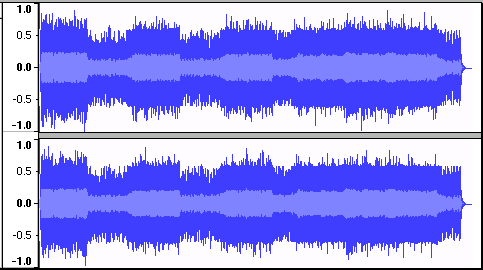
Viewed on Audacity under Linux
How bad mastering is killing the music industry
Lots of record companies blame file sharing for killing CD sales, instead of welcoming the free advertising. However:
- CD sales are actually rising, although prices are stabilising.
-
People share MP3s rather than WAV CD tracks. They do this because MP3s are smaller, and sound the same (sometimes actually better because they may sound less harsh) then the poorly mastered CD. Because of the compression, clipping and expense, the practice of using filler track to pad out the good ones and the lack of jukebox features it is not surprise that people are opting for the MP3s.
-
People master CDs loud so they are noticed on the radio and on jukebox plays. Well the "All Saints" first single "Never Ever" didn't need loudness, and nor do many today. The radio station will of course just level down the sound so the music all comes out at the same volume anyway - so the mastering compression is entirely wasted anyway. It's good for pub jukeboxes, that is all.
With clipping and without dynamics a CD sounds just like a continuous noise at home, on the Hi-Fi. So the owner just turns it down and doesn't think much of the CD.
The Blacks Eyed Peas monster clip session:
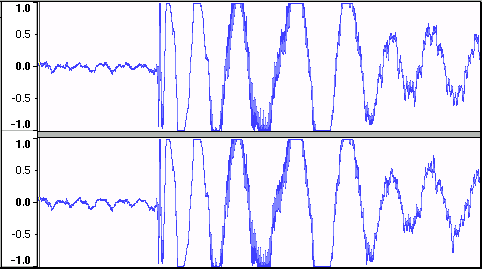
Viewed on Audacity under Linux
So 'What's goin down' in the Black eyed peas mastering stdio? Simple - it's the quality! Unplayable on Hi-Fi, this track even sounds rough in a car!!. It's like that ALL THE WAY THROUGH!!!!! I have to assume this is just a mistake, but the entire album is very very poor. The only way to listen to this CD is if you wear decent earplugs. Or run it through SeeDeClip.
'What's goin down' has 87300 clips, the longest of which is 186 samples pinned to the rail. 10.3 seconds is completely missing from that single track, sound lost as the signal waits at the clip rail.
They beat the single maximum clip with a 238 sample one (that's 5.4ms of silence) in "Rock My Shit" as a special UK bonus example of shit mastering - but 'Goin is the overall clear winner. 'Goin has an average clip rate of 270.6Hz.
Listen to it here for yourself:
DeClip restored waveforms - CD digital declip
Examples of before and after (30sec samples, fair use, educational, short clip):
The original signal may cause your DAC to saturate - and so may sound worse than the quieter one anyway. The quieter track is actually only about 2dB quieter, however you need to compare the quieter and declipped to see how a the actual quality is affected, because louder usually sounds initially better, even if it isn't. In particular listen for high freqency noise and smoothness.
- Original track section (5.2MB)
-
Quieter original track section (5.2MB)
-
Fixed with DeClip Pro V2.3 (5.2MB)
Notes
For listening tests you may like to listen on a computer connected to a hi-fi, or burn all 3 of the above samples to CD and try them out in your CD player, or save them to disk and plug your PC into the nearest Hi-Fi system. The quieter track wil probably sound better than the original track anyway because the DAC can no longer saturate, but is supplied so you can listen to both quieter (before declip) and after declip at exactly the same volume.
If you have the track, please try it. You'll find that the vocals now sound clear, the bass is well defined and stops disrupting the midrange, and the treble is sweet and unaffected by the bass now. You'll find yourself listening to the track, and the music - instead of wondering what that coarse thashing sound is (it was actually the tops of the squared off clipped signal).
The waveform change from the original to the declipped version is seen here:
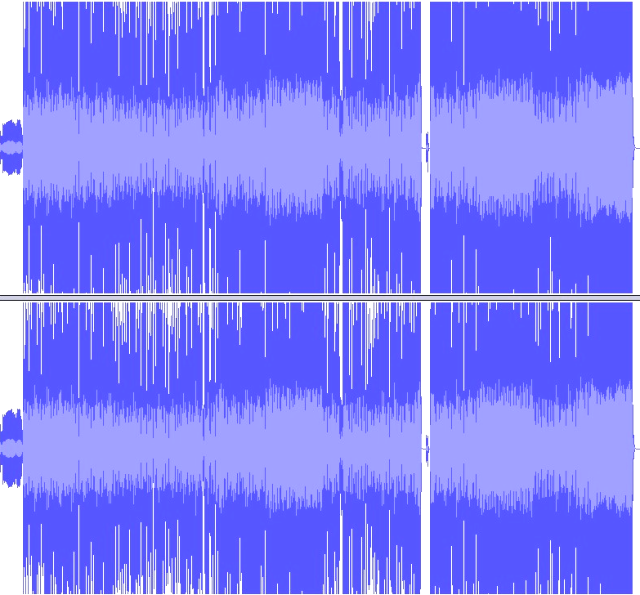 Rs 1 Pre (298.2kB)
|
|
|
It's not Hi-Fi of course, but it's a lot better that the distorted track sold by the record company.
Try DeClip out for yourself, it could be the first time you've actually listened to your CDs without large amounts of digital clipping distortion on all the loud parts. This song was missing 5seconds of sound, clipped out.
The Halls of CD mastering heaven and hell
Digital clipping and mastering links
I note that since 2008 the number of sites and forum discussion focussing on clipping and loudness wars has declined as people lose interest, it's obvious that the music industry isn't interested (we've had a decade of truly dire product that keeps getting worse) and will never change so why carry on trying?
The HiFi magazines and industry doesn't care either, the number of equipment reviews using CDs that are clearly damaged with clipping and compression shows either a disturbing level of ignorance or carelessness.
The CD problem is such that it should appear regularly on the cover each month of every (of the dwindling number of) HiFi magazine, the tacit complicity of never mentioning the problem that plagues all modern sound is another enabler for the status quo, and the inevitable continued descent of HiFi into multi channel TV sound and the polite, DAB sound that modern HiFi is afflicted with.
Try reading a typical What HiFi review and then realise that all the HiFi jargon and technospeak has been laid with a trowel was based on some of the worst quality recorded music in history - i.e. 'CD quality' Modern Pop. One then has to ask -
- What are they actually reviewing?
-
Doesn't this make the review completely meaningless?
-
When was the last time they heard a decent recording?
It almost as if the simple premise of selling poor quality audio reduces interest in people buying and playing it. Who'd have thought there may be a connection? Apparently not the Record, audio or HiFi industry.
Today everyone loves music as they walk around with iPods and headphones, but also today no one cares about music. At least SeeDeClip4 gives you a visual indication so you can choose the best versions you have and can repair much of the damage on many songs.
At the end of the day we have to question why we are paying and listening to a second rate product when the HiFi version is sitting on a hard disk at the record company, audible to no one. That makes no sense on any level.
|
|
|
|